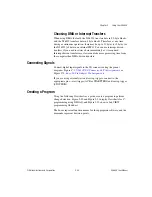
Chapter 2
Using Your NI 653X
©
National Instruments Corporation
2-19
Selecting ACK/REQ Signal Polarity
For all handshaking protocols except 8255 emulation, you can set the
polarity of the ACK and REQ signals to active high or active low through
software. By default, these signals are active high in NI-DAQ functions and
active low in LabVIEW VIs. Refer to Table C-1,
, for an overview of all control/timing trigger lines.
Choosing Whether to Use a Programmable Delay
For all the protocols, you can set a programmable delay. A programmable
delay is useful when the handshaking signals of the NI 653
X
occur faster
than the peripheral device can handle.
For all protocols except burst, the delay increases the time before the
NI 653
X
can respond to the REQ signal. For the burst protocol, the
programmable delay selects the frequency of the clock signal when you use
an internally generated clock source. You can change the PCLK frequency
by modifying the ACK Modify Amount parameter of the Digital Mode
Config VI or the ACK Delay Time attribute of the
DIG_Grp_Mode
function
in NI-DAQ C interface. Use the following table to find the resulting period
in nanoseconds. The PCLK frequency is then selected by NI-DAQ based on
this choice.
The state machine diagrams in Chapter 3,
, show more
precisely where this delay occurs in the handshaking sequence.
PCLK Period in ns
PCLK Frequency in MHz
50
20
100
10
200
5
300
3.33
400
2.5
500
2
600
1.66
700
1.43
Summary of Contents for NI 653 Series
Page 1: ...PCI 6533...
















































